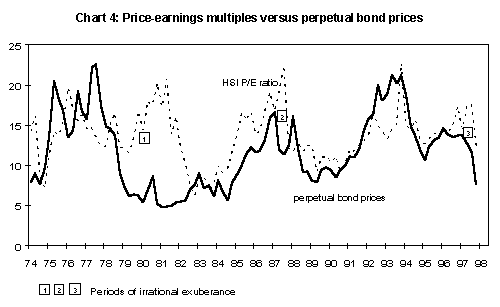Perpetual bond
Post on: 29 Июнь, 2015 No Comment

Mon Nov 24 2008 at 21:59:07
A perpetual bond is a special kind of bond that does not have to be paid back by the person who borrowed the money. This means that the only compensation a bondholder has is the interest he receives; there is no right for payback of the principal. We’ll take a look at the risks and benefits of having such bonds for both the issuer and the person buying them — infinity is a long time. A word of warning: it is said bond people are a lot smarter than stock people. This writeup, unfortunately, seems to provide evidence for this.
Anyway, the main advantage for the issuer is that capital that it doesn’t have to pay back is considered equity. and can be leveraged. This is of great value. as it allows a company to have a bigger operation without having to raise equity by issuing stock. Issuing stock would dilute the value of stock held by current investors. The main disadvantage is that payment of the interest is mandatory. whereas a company doesn’t have to pay a dividend. However, in some bonds. the company can defer the payment of the interest when it doesn’t pay a dividend. It’s like stock. only it doesn’t carry voting rights .
A second major advantage is the fact that most of these issues offer the right. but not the obligation. for the company to redeem the bond, by paying it back. In other words, the company has a call warrant on the bond. and the owner of the bond is short that warrant. The terms for this call vary; often, it may only be exercised in a few years, and then for instance once a year. The company might exercise this call if it can find cheaper money elsewhere — perhaps a regular bond, or a perpetual bond with a lower interest rate. Of course, it doesn’t have to do this; if the current arrangement is cheaper, it will just keep it. In practice, this means the company will redeem when interest goes down, and will keep the bond when it goes up.
So, in other words, the person buying this bond doesn’t know when he will get his money back and isn’t even sure of an interest payment if it’s linked to the dividend. Worse, the investor is pretty much guaranteed that he will get his money back when interest is lower, so he won’t be making as much as he would have when holding the bond. If the interest were to skyrocket. the investor would rather have the money and invest it somewhere else where it would yield even more interest. So, why would anyone buy this faux stock?
The reason is interest. The interest on these products is often very high for several reasons:
- The duration is long. Long-dated bonds are much more risky than short-dated bonds ; this is reflected in a higher interest rate.
- The interest a company has to pay is higher that a government has to pay, because the company can default. This effect is amplified by the long duration of the bond, especially for a company that might be quite solvent now, but may not be in a decade or two.
- The call option the issuer has is valuable, and the investor has to be compensated.
- Often, these bonds are subordinated. This means that should the company default. other bondholders get paid first. In practice, this more likely than not means that a default means your entire investment is gone.

For products such as these, receiving 2-3% more interest than a 10-year government bond is probably the lower limit an investor should accept. The payment should initially never be less than the dividend, either, as the dividend should go up in the long run, while the interest won’t.
Often, these products are tradable. It is worth noting that in this case, the interest is computed over the value of the principal. not the price one pays. For instance, imagine a perpetual 8% bond is trading at 70 euros with a principal of 100 euros. In this case, 1000 euros buys roughly 14 bonds, which pay 1400 * 8% = 112 euros of interest, or 11.2%. Should the company decide to pay back its bonds, it will pay 1400 euros, making the investor another 40%.
As discussed, this product is rather risky for an investor to hold. The main risks are:
- Market risk. The price of the bond can fluctuate in the market. If the investor is under no pressure to sell. this in itself doesn’t really matter, as the interest stream doesn’t change.
- Market risk for an interest rate increase. If the interest rate goes up, it would be relatively better to invest in other bonds. This will manifest in the price of the bond. If you are a private investor. you will probably find this a bit annoying; for a professional player who may have bought the bond with borrowed money, the immediate loss in the bond price hurts. As a very rough rule of thumb, a percentage point of interest rate increase may depress the value of the bond by about 5 to 10% (although I can think of many exceptions).
- Market risk for an interest rate decrease. This will move up the price of the bond-by just a little. While the perpetual bond becomes a better investment relative to other bonds, leading to a price increase, the effect is minor as it becomes very likely the issuer will redeem the bond.
- Default risk. If the market thinks the issuer will default. the value of the perpetual bond will drop very fast. Of course, if the company actually defaults, the entire investment is gone.
As one can see, there are many reasons for the price of the bond to go down, while there is very limited potential for it to go up. This is compensated for by the high fixed return. In fact, for modest price drops, say caused a 1% increase in interest rate, this return is so high that the investor is still breaking even.
In summary, a perpetual bond is a bond that doesn’t have to paid back by the issuer, but does pay a fixed interest. In this, it is a bit like a share and a bit like a normal bond. Its risk is between that of a share and a normal bond. As it is a fairly complex product with a pretty asymmetric risk profile, it’s best for advanced investors.














